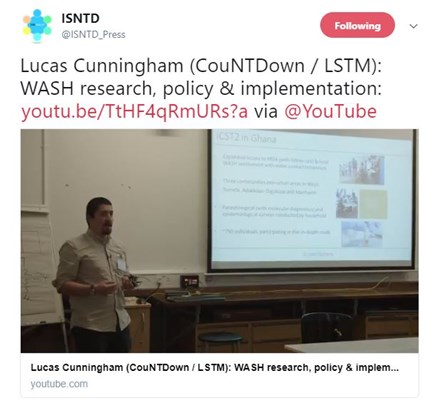
The COUNTDOWN project and its partners in Ghana from the Global Polio Laboratory Network (GPLN) and the Council for Scientific and Industrial Research (CSIR) conceived the innovative idea of using faecal samples already collected for polio testing, to also screen for Neglected Tropical Diseases (NTDs) such as schistosomiasis and soil-transmitted helminthiasis (STH). These diseases impact nearly a billion people worldwide. In a paper published in PLoS NTDs, the team from Ghana and the UK screened 448 samples to identify helminth infections.
“The study demonstrates a potential way forward in the monitoring and control of neglected tropical diseases that could be adapted and included in the legacy plan of the Global Polio Laboratory Network.” says LSTM’s Dr Emily Adams and the paper’s senior author, “we are excited at the prospect of working with this team as we go forward.’
We spoke to LSTM-based Dr Lucas Cunningham who had to liaise extensively with Ghanaian partners throughout the project; to get a better understanding of the collaborative process involved in this work.
Q: You have recently published a paper in PLoS NTDs on your work using samples collected for polio screening by the GPLN to test for the presence of soil-transmitted helminths. How did the idea to collaborate come about?
The importance of collaborating with the GPLN was evident following a series of discussions within the first year of COUNTDOWN. The GPLN’s method of screening populations for polio was a model that would suit the current interest in NTD control and surveillance, especially with regards to schistosomiasis and Soil transmitted helminthiasis.
Q: It is interesting that samples collected for polio screening can be used to identify SCH and STH. What other disease could the samples be relevant for, in terms of diagnosis?
The GPLN collect stool samples for polio testing and we have taken the novel approach of screening these same samples for evidence of schistosomiasis and soil transmitted helminthiasis, but there is the potential that these samples could be used to screen for diarrheal diseases and even respiratory infections such as Tuberculosis using faecal material.
Q: Have you found collaborating with the GPLN team a fruitful experience?
I have since worked very closely with the team in Ghana and found the experience incredibly rewarding due to their well-motivated approach to the project and having the skills required to carry out this research. The Ghanaian team have been very keen to continue working with us and are continuing to screen more faecal samples for helminth infection as they come in; adding a new dimension to their role as a surveillance service.
Q: How useful are these collaborative approaches to tackling the burden of NTDs in low to middle-income settings?
The more collaboration there is between groups and organisations that are tackling NTDs, especially those diseases with a similar epidemiology and sample analysis the better. The issue with NTDs is that they affect the poorest of our global population, often termed “the bottom billion” so any efforts that can reduce costs and streamline surveillance will be of benefit. Currently the health economics of the financial benefits of using the GPLN to screen for schistosomiasis and soil-transmitted helminthiasis have not yet been carried out, however this will be important to tell us how cost effective the current approach is.
Q: In the future, do you envision an openness to the idea of changing the sample submission policy to allow for further screening for other diseases to determine prevalence within other communities?
In the future, we hope to have these discussions with the Ghanaian health services and clinics currently involved in the GPLN. We need to garner the support of the wider community, to gather further funding to carry on studies on how best to adapt the current system to that of NTD surveillance.

To engage with other practitioners and specialists in the field, Lucas participated in a WASH research, policy & implementation session at the ISNTD WASH event on 23rd November 2017. You can watch the video of this talk below.
Please read other related blogs by Lucas and the team highlighting the journey of this work:
Building Links with Polio Surveillance in Ghana
Using Polio Samples to Assess Schistosomiasis and Soil-transmitted Helminthiasis Prevalence in Ghana
